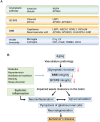Waste Clearance in the Brain and Neuroinflammation: A Novel Perspective on Biomarker and Drug Target Discovery in Alzheimer's Disease
- PMID: 35269541
- PMCID: PMC8909773
- DOI: 10.3390/cells11050919
Waste Clearance in the Brain and Neuroinflammation: A Novel Perspective on Biomarker and Drug Target Discovery in Alzheimer's Disease
Abstract
Alzheimer's disease (AD) is a multifactorial disease with a heterogeneous etiology. The pathology of Alzheimer's disease is characterized by amyloid-beta and hyperphosphorylated tau, which are necessary for disease progression. Many clinical trials on disease-modifying drugs for AD have failed to indicate their clinical benefits. Recent advances in fundamental research have indicated that neuroinflammation plays an important pathological role in AD. Damage- and pathogen-associated molecular patterns in the brain induce neuroinflammation and inflammasome activation, causing caspase-1-dependent glial and neuronal cell death. These waste products in the brain are eliminated by the glymphatic system via perivascular spaces, the blood-brain barrier, and the blood-cerebrospinal fluid barrier. Age-related vascular dysfunction is associated with an impairment of clearance and barrier functions, leading to neuroinflammation. The proteins involved in waste clearance in the brain and peripheral circulation may be potential biomarkers and drug targets in the early stages of cognitive impairment. This short review focuses on waste clearance dysfunction in AD pathobiology and discusses the improvement of waste clearance as an early intervention in prodromal AD and preclinical stages of dementia.
Keywords: Aβ clearance; blood-brain barrier; glymphatic system; innate immunity; mild cognitive impairment.
Conflict of interest statement
The author is a board member and shareholder of MCBI, Inc. (Tsukuba, Ibaraki, Japan).
Figures



Similar articles
-
Aging Brain, Dementia and Impaired Glymphatic Pathway: Causal Relationships.Psychiatr Danub. 2023 Oct;35(Suppl 2):236-244. Psychiatr Danub. 2023. PMID: 37800234 Review.
-
PTI-125 Reduces Biomarkers of Alzheimer's Disease in Patients.J Prev Alzheimers Dis. 2020;7(4):256-264. doi: 10.14283/jpad.2020.6. J Prev Alzheimers Dis. 2020. PMID: 32920628 Clinical Trial.
-
Alzheimer's disease.Subcell Biochem. 2012;65:329-52. doi: 10.1007/978-94-007-5416-4_14. Subcell Biochem. 2012. PMID: 23225010 Review.
-
Plasma neuronal exosomes serve as biomarkers of cognitive impairment in HIV infection and Alzheimer's disease.J Neurovirol. 2019 Oct;25(5):702-709. doi: 10.1007/s13365-018-0695-4. Epub 2019 Jan 4. J Neurovirol. 2019. PMID: 30610738 Free PMC article. Review.
-
Therapeutic potentials of plant iridoids in Alzheimer's and Parkinson's diseases: A review.Eur J Med Chem. 2019 May 1;169:185-199. doi: 10.1016/j.ejmech.2019.03.009. Epub 2019 Mar 8. Eur J Med Chem. 2019. PMID: 30877973 Review.
Cited by
-
The glymphatic system: a new perspective on brain diseases.Front Aging Neurosci. 2023 Jun 15;15:1179988. doi: 10.3389/fnagi.2023.1179988. eCollection 2023. Front Aging Neurosci. 2023. PMID: 37396658 Free PMC article. Review.
-
Coupling of Alzheimer's Disease Genetic Risk Factors with Viral Susceptibility and Inflammation.Aging Dis. 2024 Oct 1;15(5):2028-2050. doi: 10.14336/AD.2023.1017. Aging Dis. 2024. PMID: 37962454 Free PMC article. Review.
-
The Gut-Brain Axis and Neuroinflammation in Traumatic Brain Injury.Mol Neurobiol. 2025 Apr;62(4):4576-4590. doi: 10.1007/s12035-024-04585-8. Epub 2024 Oct 28. Mol Neurobiol. 2025. PMID: 39466574 Review.
-
Identification of circadian-sensitive brain structure and its role in cognitive impairment and dementia.BMJ Ment Health. 2025 May 11;28(1):e301142. doi: 10.1136/bmjment-2024-301142. BMJ Ment Health. 2025. PMID: 40350180 Free PMC article.
-
Decreased Expression of Alzheimer's Disease-Related Genes in Cancer May Contribute to the Inverse-Relationship-a Computational Study.ACS Omega. 2025 Apr 24;10(17):17651-17660. doi: 10.1021/acsomega.4c11571. eCollection 2025 May 6. ACS Omega. 2025. PMID: 40352571 Free PMC article.
References
-
- Gauthier S., Rosa-Neto P., Morais J.A., Webster C. World Alzheimer Report 2021: Journey through the Diagnosis of Dementia. Alzheimer’s Disease International; London, UK: 2021.
Publication types
MeSH terms
Substances
LinkOut - more resources
Full Text Sources
Medical

